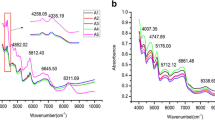Abstract
Onion (Allium cepa L.) is one of the most important vegetable crops in the Pacific Northwestern states of the U.S., and is stored for 9–12 months under bulk storage condition. Portable non-contact sensing technologies are needed to effectively detect pathogenic infections to the onion bulbs during bulk storage periods for real-time crop loss management. Therefore, portable field asymmetric ion mobility spectrometry (FAIMS) was evaluated towards detection of onion sour skin caused by Burkholderia cepacia, an important postharvest disease under bulk storage conditions. Studied were onions stored at 25 °C under two treatment conditions, inoculated with B. cepacia and with sterile water (as control), during 21-days temporal storage. Results confirmed applicability of FAIMS to detect volatile organic compounds pertinent to B. cepacia caused sour skin as early as 3 days after inoculation. Principal component analysis (PCA) score plots for FAIMS extracted data illustrated distinct clusters corresponding to inoculated and healthy treatments. PCA also suggested a significant range of dispersion field intensity (47–77%) and compensation voltage (−0.24 to 0.48 V), which could potentially be used to train portable FAIMS for real-time detection of sour skin under bulk storage conditions.





Similar content being viewed by others
References
FAO Stats (2015), http://faostat3.fao.org/browse/Q/QC/E. Accessed 12 July 2016
Pacific Northwest Cooperative Extension Bulletin, Onion storage guidelines for commercial growers (1985), https://ir.library.oregonstate.edu/xmlui/bitstream/handle/1957/16120/OnionStorage.pdf? Accessed 4 July 2016
USA Onions (2016), http://usaonions.com/storage-and-handling/. Accessed 24 June 2016
S. Agblor, D. Waterer, Onions: post-harvest handling and storage (2016), http://www.usask.ca/agriculture/plantsci/vegetable/resources/factsheet/postharvonions.pdf. Accessed 13 July 2016
C. Li, N.E. Schmidt, R. Gitaitis, Detection of onion postharvest diseases by analyses of headspace volatiles using a gas sensor array and GC–MS. Food Sci. Technol. 44, 1019–1025 (2011).
F. Maul, S.A. Sargent, C.A. Sims, E.A. Baldwin, M.O. Balaban, D.J. Huber, Tomato flavor and aroma quality as affected by storage temperature. Food Sci. 65 (7), 1228–1237 (2000)
R.M.C. Jansen, J.W. Hofstee, J. Wildt, F.W.A. Verstappen, H.J. Bouwmeester, Health monitoring of plants by their emitted volatiles: trichome damage and cell membrane damage are detectable at greenhouse scale. Ann. Appl. Biol. 154, 441–452 (2009)
B. Farneti, S.M. Cristescu, G. Costa, F.J.M. Harren, E.J. Woltering, Rapid tomato volatile profiling by using proton-transfer reaction mass spectrometry (PTR-MS). J. Food Sci. 77(5), 551–559 (2012)
R.M.C. Jansen, J. Wildt, I.F. Kappers, H.J. Bouwmeester, J.W. Hofstee, E.J. van Henten, Detection of diseased plants by analysis of volatile organic compound emission. Ann. Rev. Phytopathol. 49, 157–174 (2011)
B. Wampler, S.A. Barringer, Volatile generation in bell peppers during frozen storage and thawing using selected ion flow tube mass spectrometry (SHIFT-MS). J. Food Sci. 77(6), 677–683 (2012)
E.P. Jarvenpaa, Z. Zhang, R. Huopalahti, J.W. King, Determination of fresh onion (Allium cepa L.) volatiles by solid phase micro-extraction combined with gas chromatography–mass spectrometry. Z Lebensm Unters Forsch A 207(1): 39–43 (1998)
E. Ouellette, G.S.V. Raghavan, R.D. Reeleder, R. Greenhalgh, Volatile monitoring technique for disease detection in stored potatoes. J. Food Process. Preserv. 14, 279–300 (1990)
A. Vikram, L.H. Lui, A. Hossain, A.C. Kushalappa, Metabolic fingerprinting to discriminate diseases of stored carrots. Ann. Appl. Biol. 148, 17–26 (2006)
J.L. Varns, M.T. Glynn, Detection of disease in stored potatoes by volatile monitoring. Am. Potato J. 56, 185–197 (1979)
F. Kjeldsen, L.P. Christensen, M. Edelenbos, Changes in volatile compounds of carrots (Daucus carota L.) during refrigerated and frozen storage. J. Agric. Food Chem. 51, 5400–5407 (2003)
E. Biondi, S. Blasioli, F. Spinelli, A. Cellini, C. Lucchese, I. Braschi, Detection of potato brown rot and ring rot by electronic nose: from laboratory to real scale. Talanta 129, 422–430 (2014)
T. Konduru, G.C. Rains, C. Li, A customized metal oxide semiconductor-based gas sensor array for onion quality evaluation: system development and characterization. Sensors. 15, 1252–1273 (2015)
M. Rutolo, J.A. Covington, J. Clarkson, D. Iliescu, Detection of potato storage disease via gas analysis: a pilot study using field asymmetric ion mobility spectrometry. Sensors. 14, 15939–15952
A.D. Wilson, M. Baietto, Applications and advances in electronic-nose technologies. Sensors. 9, 5099–5148 (2009)
W. Zhao, Y. Wang, J. Li, L. Li, Q. Wang, K. Han, Y. Zhang, X. Li, P. Li, J. Luo, X. Wang, Determination of melamine in milk and dairy products by microchip-based high-field asymmetric ion mobility spectrometry combined with solid-phase extraction. Food Chem. 188, 489–495 (2015)
R.P. Arasaradnama, M.J. McFarlane, C. Ryan-Fisher, E. Westenbrink, P. Hodges, M.G. Thomas, S. Chambers, N. O’Connell, C. C, Bailey, Harmston, C.U. Nwokolo, K.D. Bardhan, J.A. Covington, Detection of colorectal cancer (CRC) by urinary volatile organic compound analysis. PLoS ONE 9(9), 1–6 (2014)
A.A. Alexander, A. Pasamontes, D.J. Peiranao, W. Zhao, A.M. Dandekar, O. Fiehn, R. Ehsani, C.E. Davis, Detection of huanglongbing disease using differential mobility spectrometry. Anal. Chem. 86, 2481–2488 (2014)
M. Rutolo, J.A. Covington, J. Clarkson, D. Iliescu, Detection of potato storage disease via gas analysis: a pilot study using field asymmetric ion mobility spectrometry. Sensors. 14, 15939–15952 (2014)
R. Sinha, L.R. Khot, B.K. Schroeder, Y. Si, Rapid and non-destructive detection of Pectobacterium carotovorum causing soft rot in stored potatoes through volatile biomarkers sensing. Crop Prot. 93, 122–131 (2017)
The Produce News (2017), http://www.producenews.com/list-all-categories2/8911-vaquero-onion-variety-celebrates-20-years-at-2012-onion-showcase. Accessed Jan 2017
B.K. Schroeder, J.L. Humann, Effects of postharvest onion curing parameters on the development of sour skin and slippery skin in storage. Plant Dis. 96, 1548–1555 (2012)
B.K. Schroeder, L.J. du Toit, Effects of postharvest onion curing parameters on Enterobacter bulb decay in storage. Plant Dis. 94, 1425–1430 (2010)
I.T. Jolliffe, Principal Component Analysis, 2nd edn. Springer series in statistics (Springer, New York, 2002).
Acknowledgements
This activity was funded, in part, by the USDA National Institute for Food and Agriculture Project WNP00745. We would like to thank Mr. C. Zuniga and Mr. C. Zhang for their help in setting the experimental unit and data collection.
Author information
Authors and Affiliations
Corresponding author
Rights and permissions
About this article
Cite this article
Sinha, R., Khot, L.R. & Schroeder, B.K. FAIMS based sensing of Burkholderia cepacia caused sour skin in onions under bulk storage condition. Food Measure 11, 1578–1585 (2017). https://doi.org/10.1007/s11694-017-9537-y
Received:
Accepted:
Published:
Issue Date:
DOI: https://doi.org/10.1007/s11694-017-9537-y




